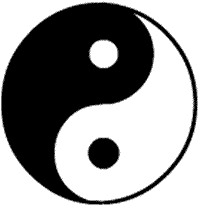Skip over navigation
Using just a pair of compasses, a ruler and a pencil, recreate this Yin Yang symbol:




Or search by topic
Number and algebra
Geometry and measure
Probability and statistics
Working mathematically
Advanced mathematics
For younger learners
Yin Yang
Age 7 to 11
Challenge Level 





- Problem
- Getting Started
- Student Solutions
- Teachers' Resources
Yin Yang
Using just a pair of compasses, a ruler and a pencil, recreate this Yin Yang symbol:

(You might like to use a black crayon or felt-tipped pen too!)
How would you explain to someone else what to do?
Why do this problem?
This challenge not only enables pupils to practise using a pair of compasses and measuring accurately, but it also provides a very good opportunity for discussing properties of shapes.Possible approach
To begin with, it might be appropriate to display the image to the whole class and invite them to describe what they see. Children could share their own method for drawing the symbol with a partner and the two could decide which of their ways might be more efficient and why.Key questions
Possible extension
Possible support
You may also like
LOGO Challenge 2 - Diamonds Are Forever
The challenge is to produce elegant solutions. Elegance here implies simplicity. The focus is on rhombi, in particular those formed by jointing two equilateral triangles along an edge.
LOGO Challenge 8 - Rhombi
Explore patterns based on a rhombus. How can you enlarge the pattern - or explode it?
A Patchwork Piece
Follow the diagrams to make this patchwork piece, based on an octagon in a square.

